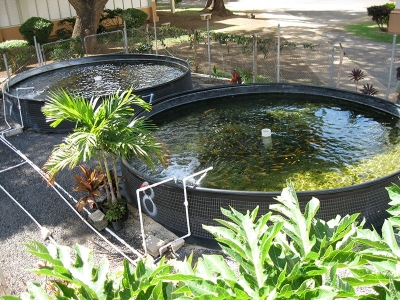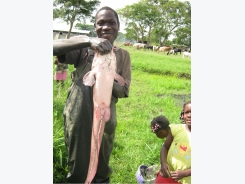5 Things I Learned While Attempting Backyard Aquaculture

Bytemarks, Flickr
Fish farming has a poor reputation: antibiotic-dependent, polluting, and reliant on industrially produced corn and soybeans to fatten the fish. It can be done in an environmentally friendly manner, but most farmed fish are raised in an industrial model much like the infamous CAFOs (confined animal feeding operations) of the livestock world.
However, some innovative aquaculturists—Will Allen of Milwaukee is perhaps the most famous of them—have devised sustainable and productive “closed loop” aquaculture systems: the poopy fish water is used as fertilizer for plants, which in turn filter the water and serve as a food source for the fish.
That’s the sort of aquaculture system I had in mind when I bought a small homestead in Georgia years ago. My plan was to raise Blue Nile tilapia, a gorgeous tropical fish that grows faster than almost any other and goes great in tacos. Armed with my well-worn copy of Small Scale Aquaculture and fresh from a day-long workshop in recirculating aquaculture systems at a local community college, I had a firm grasp on the concepts; but how to build, maintain, and successfully harvest fish from such an aquaculture system, not so much. Still, I dove in headfirst, leading to more than a few hard lessons along the way.
May Want to Start With a Degree in Engineering
My aquaculture book gave step-by-step instructions on how to build a tank, a filtration system, and a greenhouse-like cover that would maintain water temperatures in the 80-degree range that tilapia thrive in, using primarily materials found at any building supply store. I made my shopping list and headed off to Home Depot, where I spent at least three times what the book said I was going to, and returned home to build what soon felt like the Eiffel Tower.
Building an aquaculture system involves some very complex plumbing, along with PhD-level jerry-rigging. Having worked on construction crews in my youth, I have fairly strong mechanical abilities, but as I attempted to decipher the instructions in my book, I realized I probably needed a degree in engineering before getting started, not a daylong workshop in fish farming.
The filtration system included building a floating paddlewheel constructed with Styrofoam, plastic tarps, and vinyl roofing material—it’s about as crazy as it sounds—which is turned by a stream of water pumped through a convoluted series of pipes and other filtration mechanisms. This paddlewheel device, which took me two weeks to build, cost almost as much in materials as those you can buy from online aquaculture suppliers; much more when you factor in labor (I recommend the pre-fab versions). That was only the beginning: I started in the spring thinking I would raise my first batch of fish that year, but it was the following spring before I had a contraption that I thought might work.
Not as “Sustainable” as I Thought
My aquaculture system was not as much of a “closed loop”as I would have liked. It would have been much more sustainable if I’d had an array of solar panels or a wind turbine to power it. As it was, the required pump and aerator ran 24/7 from an extension cord plugged into my garage. In theory, the fingerling tilapia I started with in spring were supposed to grow to a one-pound harvestable size by fall, precluding the need to artificially heat the water through the winter (tilapia die in water temperatures below 50 degrees). But in October I found myself ordering a very expensive tank heater, as my fish were nowhere near one-pound in size when cool weather started to set in.
The unsustainable energy needed to run that heater left me with an unsustainable electricity bill, which spiked by more than $100 per month. My vision had been to raise delicious fish in the most environmentally sound way possible, while producing nutrient-rich irrigation water to fertilize other crops. Instead, I had basically built a hot tub in which to house exotic African fish—the luxurious indulgence of an idealistic young farmer.
Keep Spare Fuses on Hand
The other problem with an aquaculture system that is dependent on the electrical grid is that sometimes the power goes out. I’d stocked 100 fish in a 1,000-gallon tank, a common ratio in aquaculture, but one that is completely reliant on artificial aeration to keep the fish alive.
One day while using some power tools in my garage, I blew a fuse. Panic set in when I realized I no longer heard the burbling of my aerator. (I recommend always using a dedicated circuit for your aquaculture equipment.) And unfortunately, the old-fashioned wiring system in my quaint country home had the type of old-fashioned glass fuses that have to be replaced, not simply reset as in a modern fuse panel. I fled to the hardware store to get a fuse, and by the time I got back some of the fish were already gasping near the surface. I got the aerator going again just in time.
Then the power went out. In the dead of winter. One never knows how long the power is going to be out during a winter storm; sometimes it’s for 20 minutes, sometimes it’s for two days. I had several options: wait and see; go to Home Depot and put a gas-powered generator on my credit card; or harvest all the fish (they were nearly big enough to eat at that point). I called the power company, who said they expected it back on shortly. However, my sense of relief faded as “shortly” dragged on for several hours. By the time the power did come back on, 20 fish were headed for the freezer. The rest survived.
A Degree in Limnology is Also a Good Idea
The goal of every aspiring aquaculturist is to achieve crystal-clear water conditions. As most kids with an aquarium of goldfish can tell you, the key to this is to not overfeed. You’re supposed to give them only as much as they will eat in 15 minutes. That’s exactly what I did, yet the water was always a little murky. Since I knew that the flavor of the fish would only be as “clean” as the water they lived in, I vowed that by the time I harvested my first batch I would master what my fellow eco-aquacultuists described as the “feel” of good water chemistry: making minor adjustments until you have a well-balanced aquatic ecosystem, just like you’d find in a natural lake or pond.
But after one fretful year raising fish, I determined that creating a balanced aquatic ecosystem was more science than art. My book suggested a limnology kit—what scientists who study freshwater ecosystems use to test water quality—as an optional investment. This allows you to test the dissolved oxygen levels, pH, nitrates, phosphates, turbidity, etc. and, theoretically at least, to tweak the system where it is out of whack. This very costly kit opened me up to the world of limnology, which is fascinating, but lacking limnologist training I felt pretty helpless with all the syringes, titrators, reagents, and other such paraphernalia.
Legal Matters and Other Surprises
When spring came I organized a fish taco party to reap the fruits of my labor. The idea was to get a group of friends together to help me filet the 80 remaining fish. I would ply them with margaritas and tacos and, if all went well, end the day with a yearlong supply of fish in freezer; my unspoken hope was that, as host, I would somehow avoid having to kill and gut all those fish, a prospect that made my stomach churn just thinking about it. Luckily, I lived next door to an accomplished angler, who volunteered to oversee the fileting.
The harvest and fileting went pretty well, though there were a few surprises. I’d been told that combining catfish and tilapia in the same tank made good ecological sense: catfish are bottom feeders, while the tilapia live higher up in the water column, and together they help keep the water cleaner than either species on its own. So I’d stocked 20 catfish and 80 tilapia. I’ll never know for sure what happened in that tank, but there were no catfish on harvest day. There were, however, some fish bones in the bottom of the tank. I do know that tilapia are omnivores, so perhaps they ganged up on the smaller school of catfish.
Despite all my limnological experimentation, the water was still murky as harvest time approached. I’d heard that commercial fish farmers often replace their tank water with fresh, clean water a few days before harvest as a trick to improve the flavor of their product. This is easier said than done when you only have one tank, but I jerry-rigged a way to do it without killing the fish in the process, and my tilapia spent their last days in crystal-clear water. (For the record, the fish don’t have a problem with a bit of murk, it’s just a tactic to improve flavor.) That may work for some aquaculturists, but my tilapia, while not totally disgusting once fried up and slathered in salsa verde, did a have a scummy, slightly metallic aftertaste. My friends at the harvest party either didn’t notice the off flavor as much as I did, or were too polite to comment.
Though I did receive another interesting comment. “By the way,” said a friend at the party, “don’t you need a permit to raise tilapia?” I’d never heard of such a thing, but afterwards I looked it up on the Internet. Some states, it turns out, including Georgia, require a permit to possess tilapia, as they are considered an invasive species if they escape into natural waterways. In practice, they will only survive in places like Florida where it is warm enough for them to live year-round and reproduce, but the Georgia Department of Natural Resources and their counterparts in other southern states are worried that global warming may allow exotic tilapia, which grow like weeds and reproduce like bunny rabbits, to migrate northward.
My self-contained aquaculture system would have met their standards for preventing the fish from getting into nearby rivers and streams, but I never bothered with the permit. After an exhausting year raising tilapia the artisanal way, which netted me a freezer full of funky-flavored fish that cost as much to raise as if I’d bought them from a local fishmonger, I decided that fish farming was best left to professionals.
About Author:
Brian Barth is a contributing editor at Modern Farmer. He used to raise goats, chickens, pigs, and other critters on his farm in Georgia. But now he just writes about farming.
Related news
Tools

Phối trộn thức ăn chăn nuôi

Pha dung dịch thủy canh

Định mức cho tôm ăn

Phối trộn phân bón NPK

Xác định tỷ lệ tôm sống

Chuyển đổi đơn vị phân bón

Xác định công suất sục khí

Chuyển đổi đơn vị tôm

Tính diện tích nhà kính

Tính thể tích ao



 The Best Fish Species for Backyard Aquaculture &…
The Best Fish Species for Backyard Aquaculture &…  Innovation projects: ‘groundbreaking’ for Norwegian aquaculture
Innovation projects: ‘groundbreaking’ for Norwegian aquaculture